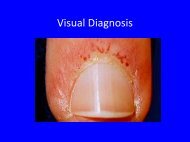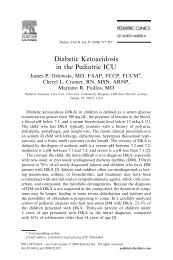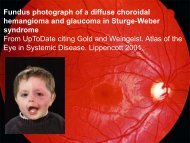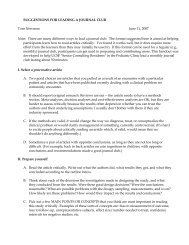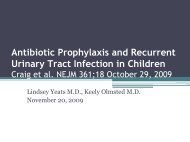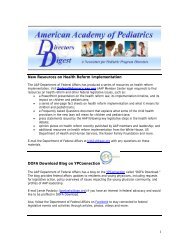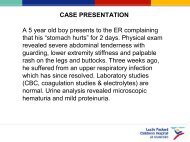DOI: 10.1542/peds.2009-1324 2010;125;e481-e488; originally ...
DOI: 10.1542/peds.2009-1324 2010;125;e481-e488; originally ...
DOI: 10.1542/peds.2009-1324 2010;125;e481-e488; originally ...
Create successful ePaper yourself
Turn your PDF publications into a flip-book with our unique Google optimized e-Paper software.
TABLE 1 Prearrest Characteristics of Patients<br />
Prearrest Characteristic Obesity (N 213) Normal Weight (N 484) Underweight (N 571) P<br />
Age, median (IQR), mo 48 (17–144) a 30 (8–132) 5 (1–16) a .001<br />
Male, n (%) 124 (58) a 225 (46) 334 (58) a .001<br />
BMI, median (IQR), kg/m2 22.7 (19.7–28.2) a 16.2 (15–18.3) 11 (9.3–12.6) a .001<br />
BMI-for-age percentile, median (IQR) 99.6 (98.5–99.9) a 47.3 (21.4–76.4) 0.01 (0.01–0.3) a .001<br />
BMI-for-age percentile z score, median (IQR) 2.62 (2.17–3.75) a 0.07 (0.79 to 0.72) 3.94 (5.73 to 2.75) a Race or ethnicity, n (%)<br />
.001<br />
White 120 (56) 275 (57) 302 (53) .40<br />
Black 44 (21) 108 (22) 141 (25) .43<br />
Other 31 (15) 66 (14) 74 (13) .84<br />
Unknown/not documented<br />
Facility type, n (%)<br />
18 (8) 35 (7) 54 (9) .43<br />
Pediatric 85 (40) 229 (47) 312 (55) a .001<br />
Adult 11 (5) 25 (5) 6 (1) a .001<br />
Mixed<br />
Event location, n (%)<br />
117 (55) 230 (48) 253 (44) .05<br />
ICU 156 (73) 333 (69) 405 (71) .48<br />
Operating room 5 (2) 24 (5) 16 (3) .10<br />
Emergency department 23 (11) 48 (10) 41 (7) .16<br />
Inpatient, monitored 6 (3) 30 (6) 32 (6) .18<br />
Inpatient ward 14 (7) 29 (6) 48 (8) .30<br />
Other/unknown<br />
Illness category, n (%)<br />
9 (4) 20 (4) 29 (5) .74<br />
Medical, cardiac 29 (14) 85 (18) 107 (19) .24<br />
Medical, noncardiac 130 (61) a 225 (46) 245 (43) .001<br />
Surgical, cardiac 8 (4) a 69 (14) 166 (29) a .001<br />
Surgical, noncardiac 10 (5) 44 (9) 42 (7) .13<br />
Trauma 33 (15) 57 (12) 7 (1) a .001<br />
Other<br />
Preexisting conditions, n (%)<br />
3 (1) 4 (1) 4 (1) .63<br />
Respiratory insufficiency 121 (57) 278 (57) 387 (68) a .001<br />
Hypotension 88 (41) 191 (39) 189 (33) .05<br />
Congestive heart failure 22 (10) a 112 (23) 195 (34) a .001<br />
Arrhythmia 38 (18) 94 (19) 115 (20) .77<br />
Infection (pneumonia or sepsis) 79 (37) a 116 (24) 157 (27) .01<br />
Renal insufficiency 29 (14) 61 (13) 66 (12) .71<br />
Hepatic insufficiency 16 (8) 31 (6) 36 (6) .82<br />
Cancer 19 (9) 35 (7) 15 (3) a .001<br />
Major trauma 40 (19) 57 (12) 8 (1) a .001<br />
Metabolic/electrolyte abnormality 44 (21) 99 (20) 128 (22) .71<br />
Toxicologic abnormality 4 (2) 6 (1) 4 (1) .35<br />
Central nervous system disorder 72 (34) 153 (32) 142 (25) .05<br />
Prematurity 8 (4) 23 (5) 120 (21) a Mode of discovery of event, n (%)<br />
.001<br />
Witnessed 193 (91) 457 (94) 543 (95) .06<br />
Monitored through electrocardiography 178 (84) 424 (88) 494 (87) .36<br />
Monitored through pulse oximetry<br />
Existing interventions in place, n (%)<br />
179 (84) 421 (87) 514 (90) .06<br />
Vascular access 193 (91) 439 (91) 506 (89) .49<br />
Arterial catheter 58 (27) 161 (33) 183 (32) .28<br />
Mechanical ventilation 124 (58) 304 (63) 341 (60) .43<br />
Vasoactive infusion 79 (37) 208 (43) 219 (38) .20<br />
Dialysis/extracorporeal membrane oxygenation 7 (3) 20 (4) 12 (2) .16<br />
a P .001, adjusted for posthoc comparisons with normal-weight group.<br />
doses, compared with 3 doses in each<br />
of the other groups; P .005), and<br />
obese patients more often received 2<br />
doses of epinephrine (43%, compared<br />
with 29% in each of the other groups;<br />
P .001). Obese patients were more<br />
e484 SRINIVASAN et al<br />
likely to receive vasopressin, magnesium,<br />
lidocaine, and amiodarone, compared<br />
with the other 2 groups (P .05),<br />
and were less likely to be treated with<br />
extracorporeal membrane oxygenation<br />
therapy (P .05).<br />
Downloaded from<br />
www.pediatrics.org by Alisa Arunamata on November 2, <strong>2010</strong><br />
Because both obesity and underweight<br />
might have resulted in advanced life<br />
support challenges, we analyzed selfreported,<br />
process-of-care, quality issues<br />
during CPR across weight categories.<br />
Overall, the obese group



